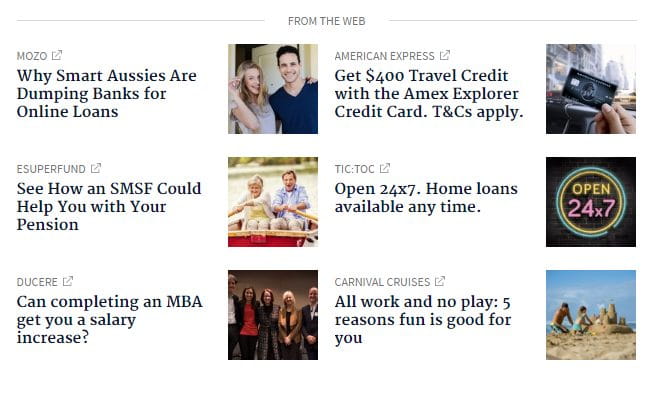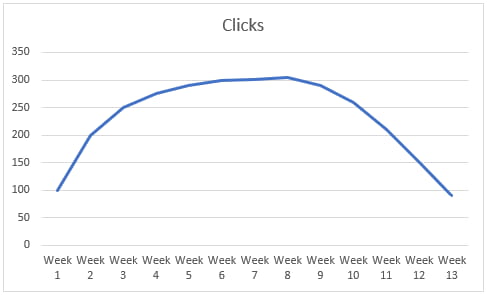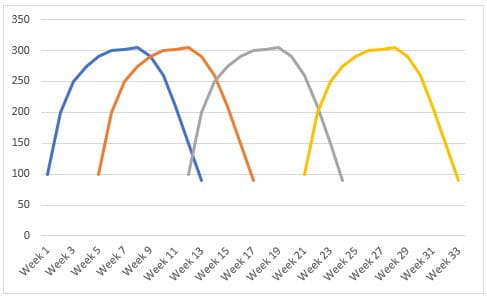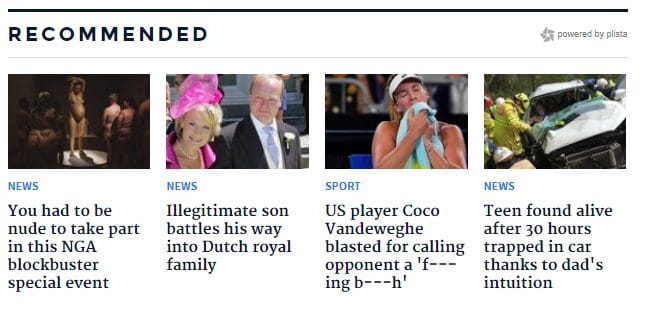You may or may not be familiar with native advertising, but you are very likely to have seen it even if you didn’t know what it was called. Native ads are in many ways almost a hybrid of Search & Display Ads…
Search ads in Google look like the organic listings save for a few small tweaks, they are styled like the rest of the page and are relevant to the topic of the search. Display ads sit in a 3rd party environment but more typically are obviously ads.
Native ads also sit in a 3rd party environment but they are styled to look like the rest of the page and are relevant to the topic of the page they sit on. They do differ in one crucial way; many native advertising providers don’t let you send traffic to a product page. More often a native ad will be an article, story or blog that is likely to be of interest to the user due to their interest in the content on the page they are reading.
Native ads are not supposed to look like ads, but other stories you might want to read. As such native advertising can be a very different beast to something like AdWords. These differences can be a dissuading factor but are really the charm and beauty of the channel.
Engage properly with users
Many products require some explaining or have a benefit or USP that solves a problem, summarising this into 80 characters or making a picture that conveys it, can be an impossible job. Producing some targeted content that addresses a pain point for the user and offers a solution, is perfect for native advertising.
This type of content is a softer sell, the user learns something valuable and can be gently nudged towards your service or product. Consequently, you will find that traffic from native ads is much more engaged with your content than users from other channels.
Engagement can take many forms, some of which provide ancillary benefits like social sharing or linking to popular content.
Brand awareness
Native ads are a great way to drive brand awareness, but not just through people being stalked by your ads everywhere they go. The users that click on a native ad, come to your site and get a brand contact, which if you’re doing it right is very likely to be a positive one.
For the reasons mentioned already, users are more engaged, and this produces a more positive brand experience even if they do not convert.
The fact that most of the worlds largest and most trusted publishers are on a native advertising platform, means you can get your content in front of huge, relevant and trusting audiences. Improvements in brand awareness can have a positive feedback loop with your other channels like Paid Search and Organic. As people become more familiar with your brand, they will be more likely to click on your listings or search for your brand.
Create long-term relationships with readers
Using remarketing to recapture these users is a great way to extend the length of the relationship, capitalising on their positive brand experience. Now that we also have things like RLSA (Remarketing Lists for Search Ads), there are more and more ways to squeeze the dollar.
Successful native advertising strategies can lead to repeat visits, higher engagement in part because it’s not a transactional exchange.
People are more likely to trust branded content than traditional advertising to a significant degree. The right in ad blockers, the usage of which is around 600 million users, implies the implicit dislike people have for ads. Which is why many advertisers are turning to this type of advertising.
Genuinely new additional traffic
With paid advertising, you often find agencies or consultants adding or heavily targeting branded traffic, which may or may not provide some value. It looks good and it makes people look good, it garners high CTR, it’s cheap and often converts very well.
The downside is you are probably not going to see your business revenue increased by what the numbers suggest. This is because very often a lot of that traffic would have come through organic search anyway.
Remarketing & RLSA can help to plug a hole, but the users are by definition not ‘new’… Each native advertising platform provides actually new additional traffic, clean and separate from all other sources. For companies that are highly optimised and need to work really hard to squeeze out a small increase in traffic; native provides a great opportunity to grow your traffic, conversions and revenue.
Drive ROI
The bottom line for most advertisers is profit, are you able to turn a profit from a channel? Well, every business is different, and it should be clear that every channel isn’t for every business. That said, native advertising can certainly deliver ROI, the high volumes of traffic at relatively low cost allow for some large range of conversions rate able to deliver ROI.
From my experience in finance, native advertising was a most welcome additional channel of new qualified traffic that provided a steady stream of new revenue.
Attribution is very important with native advertising as many users will come back to convert later. Creating remarketing lists that target traffic from your native advertising campaigns is another way to squeeze more ROI out of the channel. Aggregating the cost and revenue from the native ads with the cost and revenue from your remarketing and RLSA provides a clear top-level view of its value.
Different dynamics to Display
Before you run off to start your new native campaign, you might want to consider a few of the differences between native and other older paid advertising channels.
Native ads may initially appear to be a variation on something you are familiar with such as Display ads, but don’t be drawn into this line of thinking. If you are new to native but an old hand at paid advertising, there will be a learning curve to climb with native.
All of the basic components will be entirely familiar:
• CPC
• Clicks
• Impressions
• Conversions
• Budget
• Ads
• Campaigns
The principal component that makes native totally different is in the user behaviour and intent. For example, you may have been running Search ads for years with basically the same message; buy something for this price or at a great discount, we’re better than the rest! You might split test these and tweak them over time, but the ads are basically the same.
Lifecycle of a native ad
Native ads will have more of a character arc, depending on the size of the audience you are able to reach, you will find that you see a traffic chart like that shown below for any given piece of content:
This is because you need some time to build up data, CTR, etc before peaking. Once you have plateaued, you will be able to maintain this for some time before you start to reach saturation. Once the readership of the 3rd party sites, where your native ads are, has been saturated you will start to see a decline in performance.
As such you will need to measure this curve and plan your strategies around it, such that you maintain a certain level of performance or plan for rises and falls.
Native bidding mechanics
These in most cases need to be very small, often the platforms providing you with the service will have algorithms that need to completely recalibrate if you drastically change a CPC. This can be to the point where a sudden a large drop in CPC could completely kill an Ads performance. If you want to drop a bid from $2 down to $1.40 you would need to do this over several days knocking off $0.10 a day until you reach the desired bid.
Native Ads
Native ad platforms will have their own rules and guidelines that you must follow, these will vary between provider. That said, native ads are a different creature to Search and Display ads, they are not just a picture of discount or a rate! Native ads have their own unique set of best practices many of which transcend specific platforms.
Things like asking questions, offering an answer, using a picture containing a person are very common… The aim is to encourage click through, so you need a strong element of ‘clickbait’ without being too clickbaity!
Creatives and more traditional marketers will often have valuable input in this area, whereas the techy /analytical types may want to stick to the data.
Landing pages
As mentioned, often you aren’t allowed to deliver people to a product page, more typically you send them to a piece of content. An ad that says, “find out what your accountant won’t tell you” that leads to a page with nothing, but a pricing list is not a good user experience.
Although you can repurpose existing content, after a while (if not immediately) you will need to gear that content towards the channel itself. This is a major difference to a lot of other paid advertising, where you often select landing pages from existing content.
Summary
Native advertising provides a great opportunity to grow your digital channel, build brand awareness, drive engagement and ROI. This type of advertising is a glimpse of the future of advertising, although it’s growing in popularity, adopting it into your digital strategy now means you are probably going to enjoy a period of lower cost before it becomes ubiquitous.
There are nuances to native that demand you learn new skills or adapt existing skills, this can be seen as a barrier to entry for some. In reality, it is a relatively small learning curve and many providers offer a very high level of customer support, seminars, training and other support mechanisms.
Thanks for reading, this blog post was written by Alec Sharratt from Raptor Digital Marketing Tools.







